According to Microsoft website?
Types of cloud computing
Not all clouds are the same and not one type of cloud
computing is right for everyone. Several different models, types and services
have evolved to help offer the right solution for your needs.
First, you need to determine the type of cloud deployment or
cloud computing architecture, that your cloud services will be implemented on.
There are three different ways to deploy cloud services: on a public cloud,
private cloud or hybrid cloud.
Public cloud
Public clouds are owned and operated by a third-party cloud
service providers, which deliver their computing resources like servers and
storage over the Internet. Microsoft Azure is an example of a public cloud.
With a public cloud, all hardware, software and other supporting infrastructure
is owned and managed by the cloud provider. You access these services and manage
your account using a web browser.
Private cloud
A private cloud refers to cloud computing resources used
exclusively by a single business or organisation. A private cloud can be
physically located on the company’s on-site datacenter. Some companies also pay
third-party service providers to host their private cloud. A private cloud is
one in which the services and infrastructure are maintained on a private
network.
Hybrid cloud
Hybrid clouds combine public and private clouds, bound
together by technology that allows data and applications to be shared between
them. By allowing data and applications to move between private and public
clouds, a hybrid cloud gives your business greater flexibility, more deployment
options and helps optimise your existing infrastructure, security and
compliance.
According to Google website?
There are three different cloud computing deployment models:
public cloud, private cloud, and hybrid cloud.
·
Public clouds are
run by third-party cloud service providers. They offer compute, storage, and
network resources over the internet, enabling companies to access shared
on-demand resources based on their unique requirements and business goals.
·
Private clouds are built, managed, and
owned by a single organization and privately hosted in their own data centers,
commonly known as “on-premises” or “on-prem.” They provide greater control,
security, and management of data while still enabling internal users to benefit
from a shared pool of compute, storage, and network resources.
·
Hybrid clouds combine
public and private cloud models, allowing companies to leverage public cloud
services and maintain the security and compliance capabilities commonly
found in private cloud architectures.
From <https://cloud.google.com/learn/what-is-cloud-computing#section-1>
According to Investopedia website?
Deployment Models
There are various types of clouds, each of which is
different from the other. Public clouds provide their services on servers and
storage on the Internet. These are operated by third-party companies, who handle
and control all the hardware, software, and the general infrastructure. Clients
access services through accounts that can be accessed by just about anyone.
Private clouds are reserved for specific clientele, usually
one business or organization. The firm's data service center may host the cloud
computing service. Many private cloud computing services are provided on a
private network.
Hybrid clouds are, as the name implies, a combination of
both public and private services. This type of model allows the user more
flexibility and helps optimize the user's infrastructure and security.
From <https://www.investopedia.com/terms/c/cloud-computing.asp#toc-what-is-cloud-computing>
These many are the definitions and descriptions of Cloud Computing
at your perusal from reputed websites. Choose any one/two or many definitions
in your seminar topic article.
If you find any other related links, please add them in comment
section. That will help other students to find the material easily.
…till next post,
bye-bye & take-care.


No comments:
Post a Comment